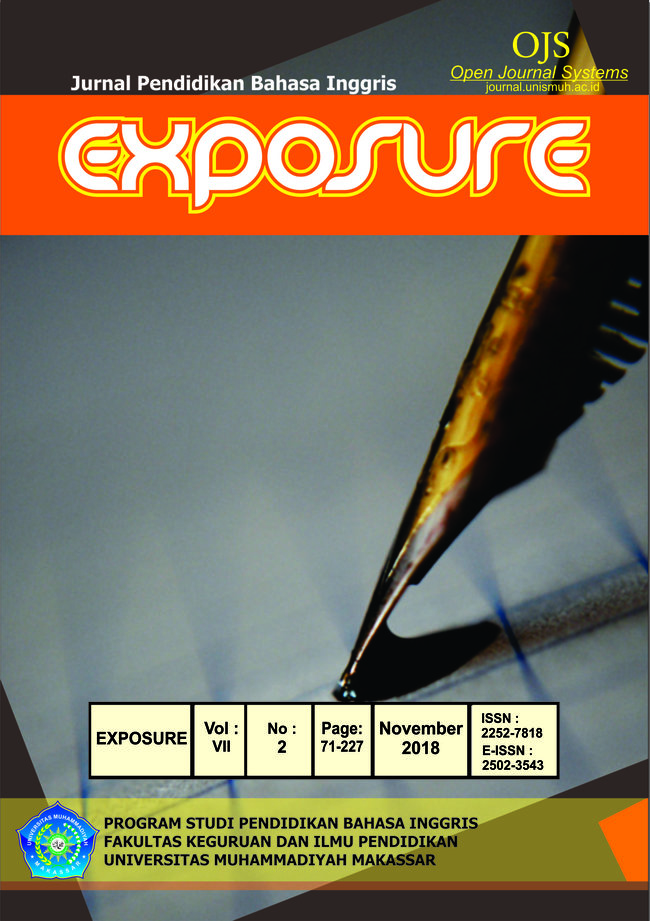THE CONTRIBUTION OF CLUSTERING TECHNIQUE IN DEVELOPING IDEAS ON A SHORT PARAGRAPH FOR THE FIRST YEAR ENGLISH EDUCATION STUDENTS OF STAI MIFTAHUL ULUM TANJUNGPINANG
DOI:
https://doi.org/10.26618/exposure.v7i2.1609Keywords:
clustering, developing idea, experimental research, writing paragraphAbstract
In writing students usually difficult in developing and expressing their ideas, they have not various sentences in writing a paragraph; they also sometimes confuse to start to make their paragraph pursuant to the topic of which given from teacher. This matter which make blase and student bored in writing. Hence from that, the researcher used a clustering technique to assist students in developing and expressing their paragraph, and help the students more variety in writing a paragraph. So that their interesting and nattier paragraph, directional and also its development pursuant to the topic of which given from the lecturer. This research is an experimental research. There was two variable of the research; there were independent and dependent variables. In conducting the data collection, the researcher conducted treatment in teaching writing in students’ developing ideas using clustering technique. The researcher gave pre-test and post-test to the students. The students write a hortatory exposition text in 45 minutes without clustering for control and the students write a hortatory exposition text in 45 minutes through clustering for the experimental group. As the result, students who are taught through clustering have different in developing ideas from those who are taught without clustering. Furthermore, it can be said that there was a significant contribution to the students’ developing ideas after using a clustering technique for the first year English student at STAI miftahul ‘Ulum Tanjungpinang.References
Brown, D.J. 1988. Understanding Research in Second Language Learning: A Teachers Guide to Statistic and Research Design. New York: Cambridge University Press.
Dickinson, Leslie.1990. Self-Instruction in Language Learning. New York: Press Syndicate of the University.
Hatch and Farhady.1982. Research Design and Statistic for Applied Linguistics. Los Angeles: University of California.
Kurtus, 2003. http://www.I:dataMyproposalreferencenewdata The Effectiveness of Clustering Technique to Teach Writing Skill Viewed from Students’ Linguistics Intelligence (An Experimental Research on Descriptive Writing, Monday, 07 November 2018.
Leanne. 1992. Reflective thinking in Teaching Writing. New York: Cambridge University.
Ventis, George.1990. Development Ideas. New York: Mc. Grow-Hill Book Company.
Downloads
Published
Issue
Section
License
Authors who publish with this journal agree to the following terms:
In order to assure the highest standards for published articles, a peer review policy is applied. In pursue of the compliance with academic standards, all parties involved in the publishing process (the authors, the editors and the editorial board and the reviewers) agree to meet the responsibilities stated below in accordance to the Journal publication ethics and malpractice statement.
Duties of Authors:
- The author(s) warrant that the submitted article is an original work, which has not been previously published, and that they have obtained an agreement from any co-author(s) prior to the manuscript’s submission;
- The author(s) should not submit articles describing essentially the same research to more than one journal;
- The authors(s) make certain that the manuscript meets the terms of the Manuscript Submission Guideline regarding appropriate academic citation and that no copyright infringement occurs;
- The authors(s) should inform the editors about any conflict of interests and report any errors they subsequently, discover in their manuscript.
Duties of Editors and the Editorial Board:
- The editors, together with the editorial board, are responsible for deciding upon the publication or rejection of the submitted manuscripts based only on their originality, significance, and relevance to the domains of the journal;
- The editors evaluate the manuscripts compliance with academic criteria, the domains of the journal and the guidelines;
- The editors must at all times respect the confidentiality of any information pertaining to the submitted manuscripts;
- The editors assign the review of each manuscript to two reviewers chosen according to their domains of expertise. The editors must take into account any conflict of interest reported by the authors and the reviewers.
- The editors must ensure that the comments and recommendations of the reviewers are sent to the author(s) in due time and that the manuscripts are returned to the editors, who take the final decision to publish them or not.
Authors are permitted and encouraged to post online a pre-publication manuscript (but not the Publisher’s final formatted PDF version of the Work) in institutional repositories or on their Websites prior to and during the submission process, as it can lead to productive exchanges, as well as earlier and greater citation of published work (see The Effect of Open Access). Any such posting made before acceptance and publication of the Work shall be updated upon publication to include a reference to the Publisher-assigned DOI (Digital Object Identifier) and a link to the online abstract for the final published Work in the Journal.




